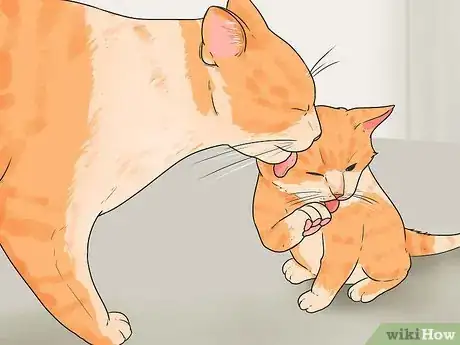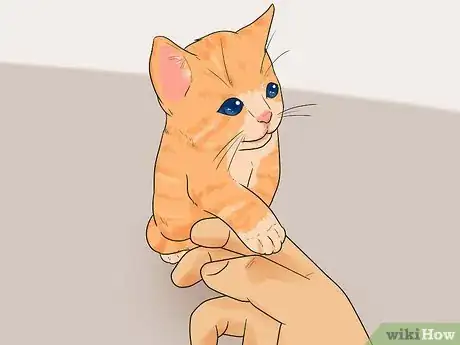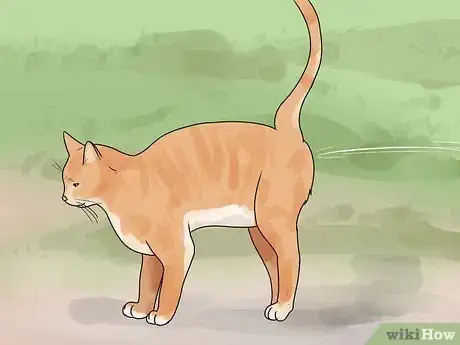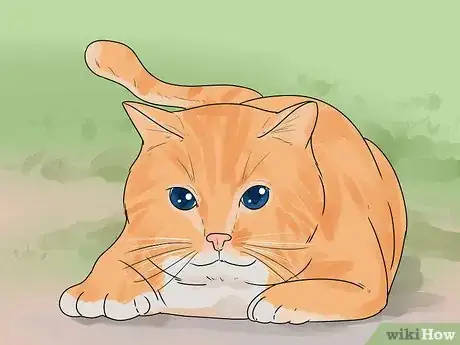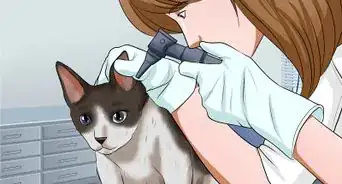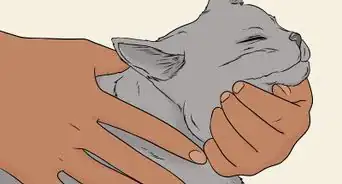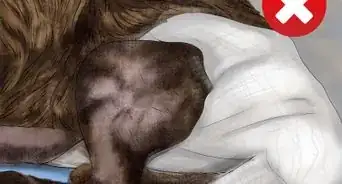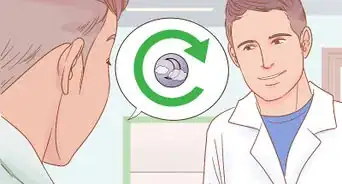This article was co-authored by Natalie Punt, DVM. Dr. Natalie Punt is a Veterinarian and the Founder and CEO of mPet- a smart phone app for pet owners to store, manage and transfer their pets medical records and health information. She specializes in small animal emergency and general medicine and veterinary practice economics. Dr. Punt holds a BS in Biochemistry and Molecular Biology from The University of California, Davis, an MS in Biochemistry from The University at Buffalo, and a DVM from Western University of Health Sciences.
There are 10 references cited in this article, which can be found at the bottom of the page.
wikiHow marks an article as reader-approved once it receives enough positive feedback. This article received 36 testimonials and 87% of readers who voted found it helpful, earning it our reader-approved status.
This article has been viewed 1,246,737 times.
If you've found, adopted, or inherited a kitten, you need to know how old it is. Kittens develop at a far faster rate than humans, and the needs of a two-week-old kitten are different from those of a 6-week old kitten. Although you can't know it's precise age, an informed estimate will help you take care of your new friend properly.
Steps
Examining Physical Traits
-
1Look for an umbilical cord stump. If you find one, you can be sure you’re dealing with a newborn kitten.[1]
- The mother usually bites the cord until it breaks. The remaining “stump” will be a small piece of tissue hanging off the kitten’s belly.
- Cats’ umbilical cord stumps usually fall off in the first 3 days of life. If your kitten still has a cord stump, it is likely only days old.
-
2Examine the kitten’s eyes. A kitten’s eyes will go through several developmental stages as the begin to open and then ultimately change color. Looking at and watching for changes in the eyes can help you assess a kitten’s age.
- Kittens do not open their eyes until they reach about ten to 14 days in age, but some do open their eyes as early as 7 to 10 days. If your kitten has closed eyes, they are likely a newborn. If your kitten has already opened its eyes, they are at least a full week old.
- If your kitten's eyes are just starting to open but still appear squinty, they may be in their second or third week of life. When kittens begin opening their eyes, the eyes are bright blue in color, regardless of what color their eyes turn later as they grow up.
- If you have an older kitten and you notice her eyes beginning to change color, she is likely around 6-7 weeks old. At this time, the irises will begin to transition to their permanent, mature color. Note that if the kitten is growing into a mature, blue-eyed cat, you may not be able to observe any color change to help you determine its age.
Advertisement -
3Check the kitten’s ears. Like the eyes, a kitten’s ears go through developmental changes in the early stages of development. You may be able to pinpoint the age of a younger kitten based on characteristics of or changes to the ears.
- If your kitten’s the ears are stuck close to her head, they are probably less than one week old. Baby kittens are born with their ear canals closed, which results in ears that appear flattened back against the head. A kitten's ears will begin to open up at between 5 and 8 days in age.
- Watch for the kitten’s ears to pop up. The kitten’s ears will take longer to open than its eyes. Though the closed ear canals begin to open at between 5 and 8 days, it takes longer for the ears to pop up visibly. The ears will pop up sometime between the second and third week of your kitten's life.
-
4Examine the kitten’s baby teeth. A good way to assess the age of both young and juvenile kittens is to check the presence and development of their teeth. A kitten with no teeth is likely a newborn, younger than 2 weeks of age. If teeth are present, you can still estimate the age based on the number and characteristics of the teeth.[2]
- The first deciduous (baby) teeth should push through the gums around 2 or 3 weeks of age. The first teeth to pop through will likely be the incisors. If you don’t see the teeth visually, you may be able to feel them by gently feeling the kitten’s gums.
- The deciduous canines begin growing at 3-4 weeks of age. These are the long and pointed teeth that grow next to the deciduous incisors.
- The deciduous premolars begin breaking through the gums at around 4-6 weeks. The premolars are the teeth that grow between the canine and molar teeth.
- If all of a kitten’s baby teeth are present but she does not yet have molars, they should be around four months of age. [3]
[4]
They should have:
- 6 incisors in the top jaw and 6 in the bottom jaw
- 2 canines on the top jaw and 2 in the bottom jaw (one on either side of the last incisor)
- 3 premolars on the top jaw
- 2 premolars on the bottom jaw.
-
5Check for adult teeth. If you find larger, adult teeth in a kitten, it is likely four months or older. The timing of the teeth may be a little less precise in an older kitten than it is in a very young kitten, but you should be able to get a good idea of the kitten’s age based on when her adult teeth come in.
- The adult incisor teeth are the first to come in, around 4 months.
- Between 4 and 6 months, the baby canines, premolars and molars are replaced by adult teeth.
- If your kitten has all their adult teeth and all four molars, she is likely at least 7 months old.
- Be aware that these guidelines are based on normal, healthy kittens; medical issues or accidents can cause teeth to be missing or come in late.
-
6Weigh the kitten. A prediction based on weight can be imprecise due to differences in size and breed, but the weight can be a factor that gives you more information about your kitten’s approximate age.[5]
- A cat's nutrition and nourishment can also impact how much it weighs.[6]
- The average healthy kitten weighs about 3.5 oz at birth, and gains about a quarter ounce per day.[7] So, a normal kitten will weighing from 3.5 to 5.25 oz is in its first week of life. (Note that a kitten weighing less than 3.5 oz may be sick or undernourished. Take the kitten to a veterinarian for evaluation.)
- A normal kitten will weigh from 4-6 oz (113-170 g) and be smaller than a human adult's hand at 1 to 2 weeks.
- Most kittens will weigh from 6-8 oz (170-225 g) when they are 2-3 weeks old.
- A kitten that weights .5 to 1 pound (225g to 450g) is likely around 4-5 weeks old.[8]
- A kitten weighing between 1.5 pounds to 2 pounds (680g-900g) is likely 7-8 weeks old.
- The average cat aged three months or more will weigh one pound per month of age until its weight stabilizes at around 10 pounds. So, a 3-pound cat will likely be 3 months old, and a 4-pound cat will be 4 months old. Though this is a generalization, it's a useful rule of thumb for cats over 12 weeks in age until the cat reaches its adult weight, which is about 10 pounds for most cats.
Assessing Behavior
-
1Monitor the kitten for signs of weaning. This step only applies to kittens that are still with their mothers. The mother will stop allowing her kitten to nurse at around 4-6 weeks after its birth. That’s when her milk begins to dry up.
- If the mother has fully weaned her kitten off milk, the kitten is probably about 7 weeks old. After 7 weeks, mother cats will no longer allow her kittens to nurse. You might notice that the kitten tries to approach its mother to nurse, but is swatted away and rejected.
- A kitten of 7-8 weeks will begin leaving her mother more frequently and for longer periods of time for more adventurous exploration.[9]
-
2Watch the kitten’s mobility. A kitten’s proficiency in walking can indicate her age based on normal development. Kittens are unable to stand or walk around until they reach around 2 to 4 weeks of age. Until then, they spend their time snuggling up to their mother and siblings, sleeping, or nursing. If a kitten needs to move in the first few weeks, they do a belly-crawl.
- Wobbliness and uncertainty when your kitten walks indicates that your kitten is around 2 weeks old.
- If your kitten is beginning to look confident in their ability to walk, they are likely older than 3 weeks.
- Between 3-4 weeks, a kitten will begin to demonstrate the righting reflex, which is the ability to turn in mid-air to land on their feet.[10]
- Around 4 weeks of age, the kitten will be able to walk more steadily and explore its environment. Its natural curiosity and playfulness will emerge with this increased mobility. Kittens of this age will begin to show pouncing behavior.[11]
- A kitten who can run is at least five weeks old. [12] [10]
-
3Observe the kitten's reaction to noise and moving objects. Although the eyes and ear canals begin opening in the second or third week of life, those senses are still developing at an early age. Response to external stimuli indicate an age of about 3.5 weeks.
-
4Assess confidence and playfulness. A healthy kitten will grow more confident around the fifth and sixth weeks of its life. This is due, in large part, to its growing coordination and mobility. A kitten of this age will begin exploring its environment more fearlessly than a younger, more hesitant kitten.
- By 7-8 weeks, a kitten should be highly coordinated and mobile. They will enjoy running around, playing and socializing with humans and other pets, and exploring higher spaces by practicing its jumping motions.
Identifying Sexual Maturity
-
1Look for signs of puberty. At around 4 months, kitten behavior begins changing as a result of changing hormones. Kittens of this age will meow loudly at night or try to escape the house to get outdoors.[13] These can be signs that the kitten is beginning to go through puberty.
-
2Watch for signs of continuing sexual maturity.[14] At 4-6 months, a kitten cat is essentially going through its teenage years. A cat of this age will begin to lose its plumpness (baby fat) and develop a sleeker body, even as it gains weight.
- Male kittens over 4 months may begin scent marking (spraying urine) to attract females to mate.
- Female kittens may begin going into heat between 4 and 6 months. This also involves scent marking, along with loud yowling and writhing about.
-
3Identify the “juvenile” stage. Kittens 7 months or older are considered juveniles, and they are both larger in size and sexually mature. Be aware that a juvenile female cat can become pregnant if she is not fixed. Along with sexual maturity comes increased aggression.
- Kittens begin to challenge other cats for dominance starting at around 6 months.[10] Juvenile kittens tend to bite more often than younger kittens or grown cats.
- Cat bites tend to occur a lot from cats in the juvenile age group, so take care when handling cats from this age group.
Confirming Age Predictions
-
1Ask the agency or person from whom you’re adopting. Good agencies and breeders keep sound records of their kittens, and will be able to provide at least a close guess. If they did not witness the birth firsthand, the best they can provide is an estimate. Even if a shelter receives a kitten well after its birth, they have an experienced staff and veterinarians who can provide professional estimates.
-
2Ask a veterinarian. When you take your kitten for its first veterinary exam, ask the vet for his or her educated estimate of its age. During this same visit, your veterinarian will also advise you on the tests and vaccines your kitten will need to lead a healthy life.
Expert Q&A
-
QuestionHow big is a 3 month old kitten?
 Natalie Punt, DVMDr. Natalie Punt is a Veterinarian and the Founder and CEO of mPet- a smart phone app for pet owners to store, manage and transfer their pets medical records and health information. She specializes in small animal emergency and general medicine and veterinary practice economics. Dr. Punt holds a BS in Biochemistry and Molecular Biology from The University of California, Davis, an MS in Biochemistry from The University at Buffalo, and a DVM from Western University of Health Sciences.
Natalie Punt, DVMDr. Natalie Punt is a Veterinarian and the Founder and CEO of mPet- a smart phone app for pet owners to store, manage and transfer their pets medical records and health information. She specializes in small animal emergency and general medicine and veterinary practice economics. Dr. Punt holds a BS in Biochemistry and Molecular Biology from The University of California, Davis, an MS in Biochemistry from The University at Buffalo, and a DVM from Western University of Health Sciences.
Veterinarian Since the cat's nourishment can impact growth, so there's no way to be completely sure without a vet. That said, a kitten that is about 4 to 5 weeks old should weigh 350 to 450 g. From there, you could add 100 grams per week.. Obviously, this is a very general rule of thumb that may work for a healthy kitten.
Since the cat's nourishment can impact growth, so there's no way to be completely sure without a vet. That said, a kitten that is about 4 to 5 weeks old should weigh 350 to 450 g. From there, you could add 100 grams per week.. Obviously, this is a very general rule of thumb that may work for a healthy kitten. -
QuestionIs weight the best way to tell a cat's age?
 Natalie Punt, DVMDr. Natalie Punt is a Veterinarian and the Founder and CEO of mPet- a smart phone app for pet owners to store, manage and transfer their pets medical records and health information. She specializes in small animal emergency and general medicine and veterinary practice economics. Dr. Punt holds a BS in Biochemistry and Molecular Biology from The University of California, Davis, an MS in Biochemistry from The University at Buffalo, and a DVM from Western University of Health Sciences.
Natalie Punt, DVMDr. Natalie Punt is a Veterinarian and the Founder and CEO of mPet- a smart phone app for pet owners to store, manage and transfer their pets medical records and health information. She specializes in small animal emergency and general medicine and veterinary practice economics. Dr. Punt holds a BS in Biochemistry and Molecular Biology from The University of California, Davis, an MS in Biochemistry from The University at Buffalo, and a DVM from Western University of Health Sciences.
Veterinarian It depends on the case. It's not always easy to be certain, as different breeds of cats will have different weights. Also, nutrition can influence a lot the weight of the pet, so that may complicate things.
It depends on the case. It's not always easy to be certain, as different breeds of cats will have different weights. Also, nutrition can influence a lot the weight of the pet, so that may complicate things. -
QuestionI found a kitten whose eyes and ears are just open. He drinks milk well, and I suspect he's about 3 weeks old. When should I start giving him kitten food?
 Pippa Elliott, MRCVSDr. Elliott, BVMS, MRCVS is a veterinarian with over 30 years of experience in veterinary surgery and companion animal practice. She graduated from the University of Glasgow in 1987 with a degree in veterinary medicine and surgery. She has worked at the same animal clinic in her hometown for over 20 years.
Pippa Elliott, MRCVSDr. Elliott, BVMS, MRCVS is a veterinarian with over 30 years of experience in veterinary surgery and companion animal practice. She graduated from the University of Glasgow in 1987 with a degree in veterinary medicine and surgery. She has worked at the same animal clinic in her hometown for over 20 years.
Veterinarian Try to give him KMR (kitten milk replacer) rather than cow's milk. The mother cat starts to wean her young from about 4 weeks of age, so keep going with the KMR for another week or so. First make sure he can drink KMR from a bowl rather than a syringe, and then add some KMR to canned kitten food to make a thick gruel or soup. As the kitten learns to drink this, gradually thicken it up by reducing the amount of KMR.
Try to give him KMR (kitten milk replacer) rather than cow's milk. The mother cat starts to wean her young from about 4 weeks of age, so keep going with the KMR for another week or so. First make sure he can drink KMR from a bowl rather than a syringe, and then add some KMR to canned kitten food to make a thick gruel or soup. As the kitten learns to drink this, gradually thicken it up by reducing the amount of KMR.
References
- ↑ http://scienceline.ucsb.edu/getkey.php?key=363
- ↑ Natalie Punt, DVM. Veterinarian. Expert Interview. 14 September 2021.
- ↑ http://www.vcahospitals.com/main/pet-health-information/article/animal-health/retained-deciduous-teeth-baby-teeth-in-cats/2247
- ↑ http://www.vivo.colostate.edu/hbooks/pathphys/digestion/pregastric/catpage.html
- ↑ Natalie Punt, DVM. Veterinarian. Expert Interview. 14 September 2021.
- ↑ Natalie Punt, DVM. Veterinarian. Expert Interview. 14 September 2021.
- ↑ http://www.aspca.org/pet-care/cat-care/newborn-kitten-care
- ↑ Natalie Punt, DVM. Veterinarian. Expert Interview. 14 September 2021.
- ↑ http://www.cat-world.com.au/kitten-development
- ↑ 10.010.110.2Vicky Halls, The Secret Life of Your Cat, p. 69, (2010), ISBN 978-0-600-62138-6
- ↑ http://www.arubakitten.org/?page_id=288
- ↑ http://www.arubakitten.org/?page_id=288
- ↑ http://www.catster.com/kittens/4-month-old-kitten
- ↑ http://www.vetstreet.com/cats/your-kitten-what-to-expect-at-4-to-6-months
- ↑ http://www.aspca.org/pet-care/virtual-pet-behaviorist/cat-behavior/socializing-your-kitten
About This Article
To tell how old a kitten is, check to see if it still has its umbilical cord stump, if its eyes are closed, and if its ears are stuck close to its head. If you notice these features, the kitten is likely less than 1 week old. If your kitten's eyes are open and its ears have popped up, it is probably 2-3 weeks old. As the eyes and ears open and the kitten begins to develop its senses, it will start to react to external stimuli at about 3.5 weeks old. For more advice from our Veterinary reviewer, including tips on how to use a kitten’s behavior to determine how old it is, keep reading!







